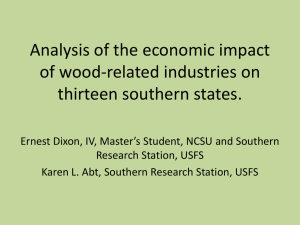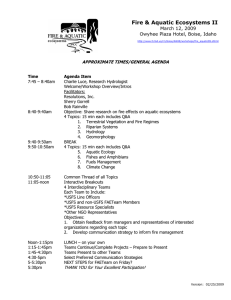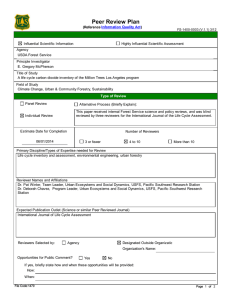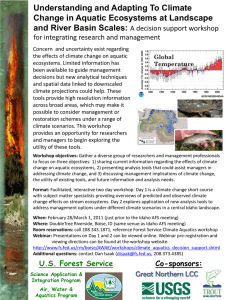REVIEW OF USDA FOREST SERVICE COMMUNITY-BASED WATERSHED RESTORATION PARTNERSHIPS APPENDIX E
advertisement
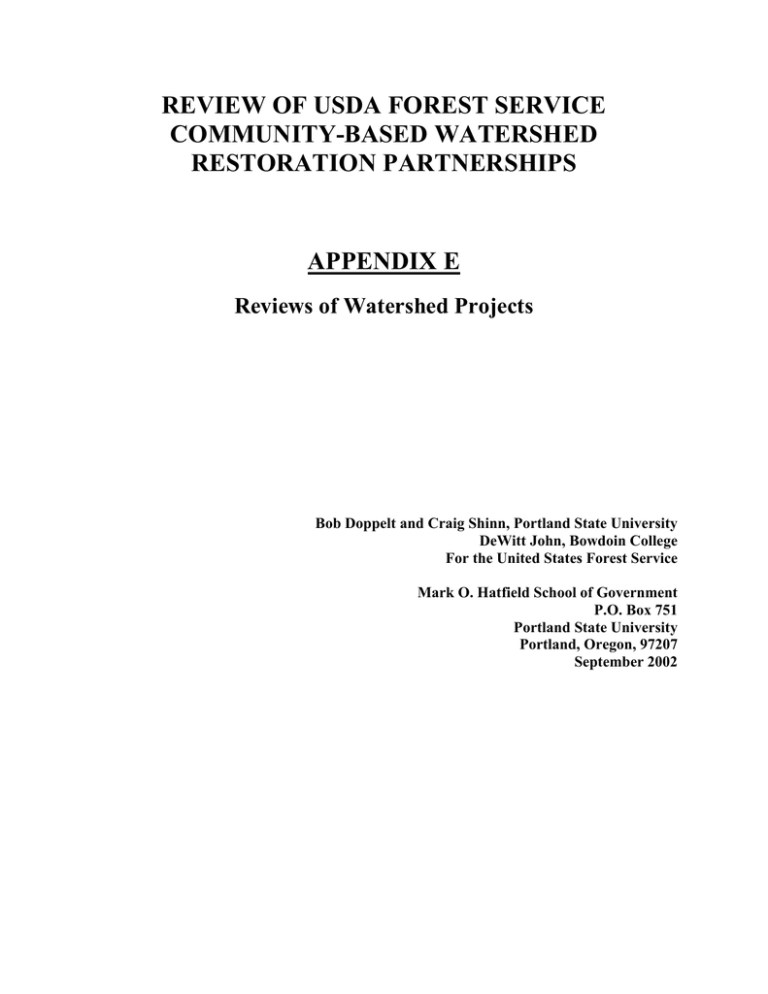
REVIEW OF USDA FOREST SERVICE COMMUNITY-BASED WATERSHED RESTORATION PARTNERSHIPS APPENDIX E Reviews of Watershed Projects Bob Doppelt and Craig Shinn, Portland State University DeWitt John, Bowdoin College For the United States Forest Service Mark O. Hatfield School of Government P.O. Box 751 Portland State University Portland, Oregon, 97207 September 2002 LOWER MISSISSIPPI ALLUVIAL VALLEY (RESTORING THE DELTA) Completed Summer 2002 The Lower Mississippi Alluvial Valley large-scale watershed restoration project--called Restoring The Delta--started just over 16 months ago. It was originally conceived by the Center for Bottomland Hardwoods Research, a USFS Research lab in Stoneville, Mississippi. Proposals by Ducks Unlimited (DU) and the USFS were combined to form Restoring the Delta. No funding was provided for research when the large-scale program was developed, so the research center dropped out. Restoring the Delta is therefore a partnership primarily between DU, The Delta, the St. Francis National Forest and the Arkansas Forestry Commission. Arkansas Game and Fish Commission and NRCS in Arkansas are also involved. The primary goal is to restore two million acres of vegetation and one million acres of hydrology over 20 years. To achieve this, they want to ensure that reforestation activities conducted by state forestry agencies and the Forest Service are integrated with the activities of the other state, local and federal agencies and nonprofits in efforts to restore the Delta. The $500,000 in funding provided for the project in the first year was split between the Arkansas Forestry Commission and DU. Most of the funds were used to provide free tree seedlings to landowners. Since Its Inception, the Project Has Provided Some Important Benefits: • The partnership has broken down barriers and developed better working relationships between the USFS and the Arkansas Forestry Commission, Ducks Unlimited, and other state and federal agencies and non-profit groups. • The project has also allowed the USFS to take on a larger role in efforts to restore the Lower Mississippi Alluvial Valley. • The designation as a national demonstration project and the hiring of a project coordinator has opened the door to leveraging additional money. • Coordination with and support from USFS Region 8 office has been good. At the Same Time, When We Reviewed the Project, We Found a Number of Obstacles • Some lingering hard feelings exist among the key partners over the top-down way that the project began. • The partnership guidelines have continually changed which has drained valuable staff time and energy. • • Setting priorities among the partners has been difficult to achieve. The funding provided for the project is insignificant compared to other public entitlement programs available to landowners, and therefore, has not been sufficient to entice much participation by landowners. As a result, at the time this review was completed only three projects have been completed. • The Wyden Amendment has been difficult to use and has slowed decision-making. • The direction and support from the Chief's office has been unclear at best. • As a result of the above, Restore the Delta does not have much to offer private landowners and, consequently, its achievements have been, at best, modest. Our Assessment of the Project Suggests That: • Many of the constraints exist because not all of the key partners are fully committed to the project. • There does not appear to be a person with sufficient credibility and trust among the partners to lead the process and help the groups develop a consensus on key priorities. • The number of partners involved seems too limited to create the broad-based buy-in needed to achieve long-term success. • The current partners view the project as primarily an extra source of funds, not as a means to develop a comprehensive restoration plan for the Lower Mississippi Alluvial Valley. • As a consequence of the above, no strategy or overall framework has been developed to guide the overall project and the focus is primarily on individual projects. • As a result, despite being relatively new, progress seems unusually limited. To Overcome These Obstacles and Provide a Pathway For Potential Future Success, We Recommend: • A credible, respected person should be identified or recruited to join the partnership board in a leadership role. • Once a credible leader is engaged, continued improvement should be made to the governance system (the way information is generated and shared, decisions are made and enforced, and resources are distributed). • An effective outreach, marketing, and communication plan should then be implemented to apprise more landowners, local governments, non-profits, community groups, and others about the program and expand awareness and participation. • Enhanced outreach must be linked with efforts to obtain and/or leverage significantly more money for the project. • Steps should be taken to clarify how the Wyden Amendment can be used more widely for priority projects off National Forest lands. • Improved direction and support from the Chief's office will be vital to helping the project achieve long-term success. Successes • The Partnership Has Broken Down Barriers and Developed Better Working Relationships Traditionally, in this region a wall has existed between foresters and wildlife people. The partnership has developed better working relationships between the USFS, Arkansas Forestry Commission, and Ducks Unlimited. As a result of a series of meetings with senior leaders and line officers from Arkansas government agencies, the Forest Service and DU a set of guidelines was developed on how the partnership will operate. This was a significant accomplishment and helped establish a framework for working together. • The Lower Mississippi Alluvial Valley Large-Scale Watershed Project Has Allowed the USFS to Become More of a Player Most of the partners we spoke with said because bottomland hardwoods are so important to restoring the Lower Mississippi Alluvial Valley, the USFS and Arkansas Forestry Commission must play critical roles. Prior to the start of this project, the USFS and state forestry agencies played relatively minor roles. The large-scale watershed program has provided a platform for the USFS and AFC to become more active participants. • The Addition of Forestry Agencies Has Added an Important New Restoration Tool Related to the point above, the focus on reforestation has added an important new tool to the restoration toolbox in the Lower Mississippi Alluvial Valley. • The Designation as a National Demonstration Project and the Hiring of a Project Coordinator Has Opened the Door to Leveraging Additional Money Because of the national spotlight the demo provides, the project is currently trying to leverage one million dollars from the Army Corps of Engineers and seeking other nontraditional funds as well. The Arkansas Forestry Commission is trying to leverage funds from EPA for work on the L'Anguille River. The full-time coordinator has been a key to having personnel who can identify funding sources and do the work needed to secure funds. The partnership provides an umbrella through which multiple funding sources could be secured. • Coordination with and Support from Region 8 Has Been Good The Forest Service staff involved said they have received good support from staff at Region 8. Local staff said the former Regional Forester, Elizabeth Estelle, was very supportive and allowed the Deputy Regional Forester (Dave Holland) and Ray Johnston to assist as needed. Obstacles and Limitations • Hard Feelings Exist Over the Top-Down Way In Which the Project Began Every partner we spoke with said lingering resentment exists over the fact that the project began through direction from the Chief's office. The project was dropped on people as a surprise and more than one partner said there is significant resistance among some state agencies within the Delta to doing new things. Ironically, at the same time, each of the partners acknowledged that the project would never have started without the proactive effort from the Chief and Jim Sedell's group. • The Partnership Guidelines Have Continually Changed and Priority Setting Has Been Difficult The initial guidelines that were developed for how the project would operate have been continually changed due to feedback from private landowners. This has frustrated the staff and consumed a good deal of time. Although there are many reasons for restoring bottomland hardwoods in the Delta, it was very difficult for the partners to come to agreement on what the priorities should be. A comprehensive watershed analysis is being developed. However, because it is not yet completed, agreement on priorities has been difficult to achieve. Almost every person we spoke with said the effort to develop a common approach and priorities has eaten up significant time and energy with little result. Everyone wants something done, but the group cannot agree on priorities. As a result, projects have been pursued in a purely opportunistic manner and a common vision, goals, and strategy have not been developed. • The Funding Base Is Too Limited to Entice Landowners to Participate There are a number of federal programs within the Delta that provide funds to private landowners for various types of restoration. The partners have therefore tried to find ways to target their limited funds to fill niches not currently being served by the other programs. Only 100,000 acres of the almost 24 million acres involved in the project are on National Forest land, so targeting their efforts to private lands makes sense. The amount of funds available, however, is so small that the partners decided to limit the program to providing free tree seedlings to private landowners. This is not a sufficient enticement to landowners, especially when they are used to getting paid through entitlement programs for restoration activities, and when plantings on even marginal lands takes those lands out of production, thereby reducing farm income. One partner said the three landowners who have responded so far were going to plant trees anyway. Without sufficient funds there is no way to develop an effective program. One state government employee summarized this problem by stating, “Twenty-five million acres in the Delta with $100,000 is not restoration, it’s just planting a few trees." Another partner raised concerns that spreading the word about the program without sufficient funds to back it up could lead to trouble. Even though participation has been limited so far, “If this program grew really popular and we only had $95,000 to give out, it could be even worse." • Outreach and Marketing to Landowners Has Found Limited Success The partners advertised the assistance available through the project to landowners in those areas that were deemed priorities, but got a very limited response. The partners believe the lack of response is due to the amount of funding and type of assistance available (free tree seedlings) and the fact that it takes time for word of the project to spread among landowners. Yet, most of the people we spoke with also acknowledged that outreach and marketing has been weak. As a consequence, only three projects have been implemented so far. One of the partners summarized the sense of constraints the program has worked under by stating, "In all fairness it’s brand new and we kept our focus narrow. But, we have not had people beating down the door." • The Wyden Amendment Has Been Difficult to Use The type of funds the program has received constrains the type of work that can be accomplished. Inventory and monitoring funds, for example cannot be used to buy and plant trees. The program has used the Wyden Amendment to channel funds for work on high priority projects off Forest Service lands, but the qualification that Wyden Amendment funds must "benefit the USFS" has been problematic to agency staff. The partners we spoke with said there are many benefits that will accrue to the USFS through this program, but as National Forest lands are often far from the private lands in the Delta, the benefits are difficult to quantify. • As a Result of the Above, Decision-Making Has Been Slow It took six months for staff at Region 8 to respond to a request for clarification on what "beneficial to the USFS" means in relation to the Wyden Amendment. Decision-making was put on hold while local USFS staff waited for the response from the Regional Office. Hence, significant time was lost and the partners had to decide for themselves what "beneficial" meant. • State and Private Forestry Has Insufficient Funds Because so much of the land involved in the project is private land, the partners said it would be best if at least 2/3 of the funding come through State and Private Forestry and only about 1/3 through the Wyden Amendment. The funding mix currently tilts the opposite way. • Direction and Support From the Chief’s Office Has Been Unclear At the time of this review, the partners said they were unsure about the level of support and direction from Washington about the importance and future of the project. Even if there will not be money available off-the-top in the future, the partners said the Chief's office must continue to provide strong leadership and technical assistance for the project and ensure that a significant amount of additional money is provided if the project is to succeed. Analysis • Not All of the Key Partners Are Committed to the Process Due to the lack of sufficient funding, the perceived lack of long-term support from the Chief's office and other reasons, we found weak buy-in from some of the key partners. The lack of commitment and buy-in can be understood by comparing the views of Ducks Unlimited and the Arkansas Forestry Commission regarding the importance of the project. DU believes the project is very important and much would be lost if it ended. The Arkansas Forestry Commission believes that because the funds are limited and not much has happened anyway, little would be lost if the program ended. Unless issues such as the level of funding, decision-making problems, and long-term concerns about the Chief's commitment are resolved, it seems unlikely that the key partners will fully commit or that many additional partners can be engaged in the program. • Lack of Sufficient Leadership Has Constrained Progress A person with exceptional leadership skills can often help groups with diverse views overcome their individual interests and develop agreement on difficult issues. This type of leader usually has a high degree of credibility with the participants and is viewed as fair, objective, and forward thinking. It appears as though this type of leader does not yet exist among the partners. Lacking effective leadership, the partners continue to struggle to forge a common mission, goals and strategy. • The Number of Partners Involved Seems Too Limited At the time this review was completed, the project had just four dominant partners. This number seems too small to achieve the goals that have been established for the project. Despite the fact that the project is aimed almost exclusively at private landowners, no private landowners or local governments apparently sit on the partnership. The addition of new state, federal, private and non-profit partners may substantially increase the funding base and open the door to new ideas and approaches. Conversely, without the active involvement and support from more partners, long-term success seems doubtful. • The Partners View the Project as Primarily a Source of Extra Funds, Not as a Means to Develop a Comprehensive Restoration Plan for the Lower Mississippi We could not identify an overall framework or strategy from which the partners were operating. We also found very little discussion about the need for an overall restoration strategy for the Delta or the role that the partnership could play in developing one. Instead, we found that the key partners are focused almost exclusively on tactics-individual projects--using an almost entirely opportunistic approach. As a consequence, the partners viewed the project primarily as a source of additional funding. The development of a common vision and overall strategy could help the partners raise their sights beyond the tactical, project-by-project approach, to a broader strategic approach. This step may be a key to leveraging significant additional dollars and engaging more partners, which could help resolve some of the key constraints the partners mentioned in this review. • Despite Being a New Program, as a Result of the Above, Progress Seems Unusually Limited As a result of the issues described above, at the time of this review, progress appears to be very limited. One of the key partners bluntly stated, "This project has not done a damn thing yet." This comment summarizes the sense we got from most of the partners. Recommendations • Identify or Recruit a Credible Leader Explicit efforts should be made to identify and recruit an individual or individuals whom all of the partners trust to provide leadership for the partnership. Staff can support this person. However, a leader is needed to help the group move beyond their own parochial interests so that a common vision, goals, and strategy can be agreed to and implemented. • Expand the Number of Partners For Restoring the Delta to succeed, numerous states, federal, local government, and nonprofit partners must be engaged. Concerted effort must be made to contact and engage additional partners. • Develop Greater Clarity on the Vision, Goals, Strategy and Implementation Plan Our review suggests that it will be important to develop further clarity over the vision and goals for restoration of the Lower Mississippi and to then turn this information into a well thought out strategy that leads to an efficient implementation plan. The lack of clarity on vision, goals, and strategy may lead to continual confusion over how funds should be spent and which projects to pursue. It may also reduce the number of partners that are willing to fully commit to and participate in the project. Vision refers to a picture of the future of the watershed as a restored and healthy system and to a related future of the partner organizations as more effective entities. An effective vision also includes a clear message about why people should strive to create this future. Strategy refers to the overall approach--the framework within which you make decisions--that will be used to achieve the long-term vision a partnership has developed. A sample strategy may be to first identify and protect the healthier areas of the watershed and then focus restoration activities around expanding and reconnecting these areas. Tactics are the specific actions the partners will take to implement the strategy. For example, in this example, federal agencies may target their assessment and land management activities on protecting and restoring the best remaining areas on public lands while the states and non-profits may identify and work with parties that own the healthier private land areas to acquire conservation easements and/or help them adopt new management practices. Implementation plans detail the specific sequence of steps, time-lines, lines of responsibility, fiscal, and other resources that will be employed to implement all of the tactics consistent with achieving the strategy. It is important to remember there is a direct link between the vision the partners develop, the generation of new ideas, and the development of an effective strategy. Innovative ideas that lead to synergy between all partners will arise only when partners agree on a common vision and goals and open themselves to new ways of thinking. New ideas will not emerge through business-as-usual. It may behoove Restore the Delta to spend time to clarify the vision, goals, and strategy they want to use to employ. • Continue to Improve the Governance Structure and System Although the partnership is intended to produce group decisions on priorities, it does not appear as though the governance structure and system is working as well as people would like. For example, the group could not come to consensus over the priorities. One of the partners summarized the frustration with the unwillingness of the partners to make joint decisions by stating, "Supposedly everyone runs their plans through this group, but it does not really happen." Efforts should be made to re-clarify the way that information will be gathered and distributed, how decisions will be made and enforced, and how funds and other resources will be distributed among the partners. This may require that underlying turf and other issues be surfaced and openly discussed. There are a number of ways in which watershed partnerships can be structured. There are also a number of ways in which governance systems can be organized. The governance structure and system chosen should be based on the needs and goals of the participants. This process could start by asking all of the partners to examine the needs, perspectives, and operating styles of the other partners. Based on this assessment, the most appropriate structure and decision-making system can be chosen. Options include these and other governance structures: Joint Ventures: The USFS combines with other organizations to form a new, distinct organization in order to pursue complementary objectives. When in a joint venture, information, decision-making, power, and resources are equally shared. Strategic Alliances: Similar to a joint venture, where the USFS joins with others to pursue mutual gain, but a new organization is not created. In this case, the various organizations involved must agree to cooperate with and depend on each other. Clear rules of engagement must be established and agreed to (often in writing). Informal Networks: Organizations join forces to capitalize on potential efficiencies in the production of specific outcomes. Each participating group is responsible for one area of output and the participating organizations are highly dependent on one another for the ultimate delivery of their products. Each entity makes decisions unilaterally, although in consultation with other partners. Consortiums: The USFS pools its resources with other organizations to procure access to information or technologies, or achieve goals that are too costly or difficult for one entity to do alone. No separate entity is created for the management of this relationship. Each entity makes decisions unilaterally, although in consultation with other partners. Each of these structures and systems operate under different rules of engagement. The partners involved with Restoring the Delta need to spend time to understand the different structures and systems and choose a model that best fits their needs. • Institute Effective Outreach, Marketing, and Communication Programs Although limited funding has caused the partners to be hesitant to do much promotion, this may be a Catch-22 situation. Lack of demand due to lack of public awareness may continue to limit the funding available. Increased demand may lead to new funding sources. Well-developed and executed outreach, marketing, and communication programs are needed to increase awareness of the project among private landowners and local governments. • Clarify How the Wyden Amendment Can Be Used The requirement that funds distributed through the Wyden Amendment must be "beneficial to the USFS" has proven confusing and difficult to apply. The partners said they are uncomfortable with having to continually decide on their own what "beneficial" means. It may prove helpful to clarify the scope of beneficial activities. Funds are needed that can be used as the partners see fit to get the work done. • Secure Additional Funding A significant infusion of funding will be needed for Restoring The Delta to succeed. A number of the partners involved with the project said because it seems it will not be possible to receive future funds off the top, and because the funds they have received have been difficult to utilize on private lands, the best funding approach for this particular program may be to consider a line-item appropriation from Congress. Other funding options should also be pursued. • Continued Support from the Chief's Office Is Vital for Long-Term Success The Forest Service employees involved with Restoring the Delta said if the direction and support from the Chief's office for the Large Scale Watershed Programs ended, they feared that the project would eventually die. If support and direction from Washington ends, the Regional Office will be forced to choose among many priorities and as the large-scale watershed programs are new and not yet embedded in the culture of the agency, the program may most likely eventually die at the regional level. The program needs solid long-term national level support to succeed. One employee summarized this feeling by saying, "If they are not going to go out full force and make a full commitment to the program, they should get out of the business."


